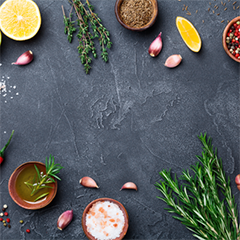There’s a sad little post-Halloween ritual in Britain that’s enough to make a chef weep.
Once the jack-o’-lanterns have served their ghoulish purpose, we toss thousands of tonnes of perfectly edible pumpkins out with yesterday’s cobwebs and plastic spiders.
According to the environmental charity Hubbub, around 18,000 tonnes of pumpkins head for landfill annually – in real terms, that’s more than 15 million pumpkins. That’s also good food rotting away – food that could be spiced, roasted, mashed and spooned onto plates all winter long.
Mike Davies, chef-owner of The Camberwell Arms and author of new cookbook Cooking for People, has a message for us: save the pumpkins. They’re the unsung heroes of the season, he says, and more than capable of being transformed into the kind of comfort food that makes chilly autumn nights bearable.
“Pumpkins have both a rich diversity of flavour profiles and textures, which makes them ideal for many different uses,” he says. “They work just as well taking a lead role in a dish as a subsidiary component.” It’s this philosophy that runs through Davies’ new book, featuring pumpkin in dishes that bring deep, warming flavours to the table. “My cooking is about promoting things at the peak of their season, and encouraging their intrinsic brilliance with a simple approach to cookery.” For Davies, it’s time we gave the humble pumpkin its proper due in the British kitchen.
Choosing the right pumpkin for the job
If you’ve tried roasting pumpkin, only to end up with a tray of dry, grainy chunks that could double as doorstops, you’re not alone. The problem, Davies explains, is often in the variety. “Something with a naturally drier, firmer texture will probably need a little more help from fats or liquids to balance the moisture than a wetter pumpkin,” he says. It’s pumpkin-picking 101: don’t grab the first one in the aisle. For beginners, butternut squash is a good call. Or, if you’re feeling adventurous, try a Delica or Violina – these varieties are rich, creamy and soak up flavour like sponges.
If you’re wondering how to get the best out of different varieties, Davies has a tip: “It’s important to think of the role of pumpkin in the dish you’re planning; consider the structural integrity as well as the level of sweetness.” He tends to start with a seasonal building block like pumpkin, and then designs a dish around it to make it shine.
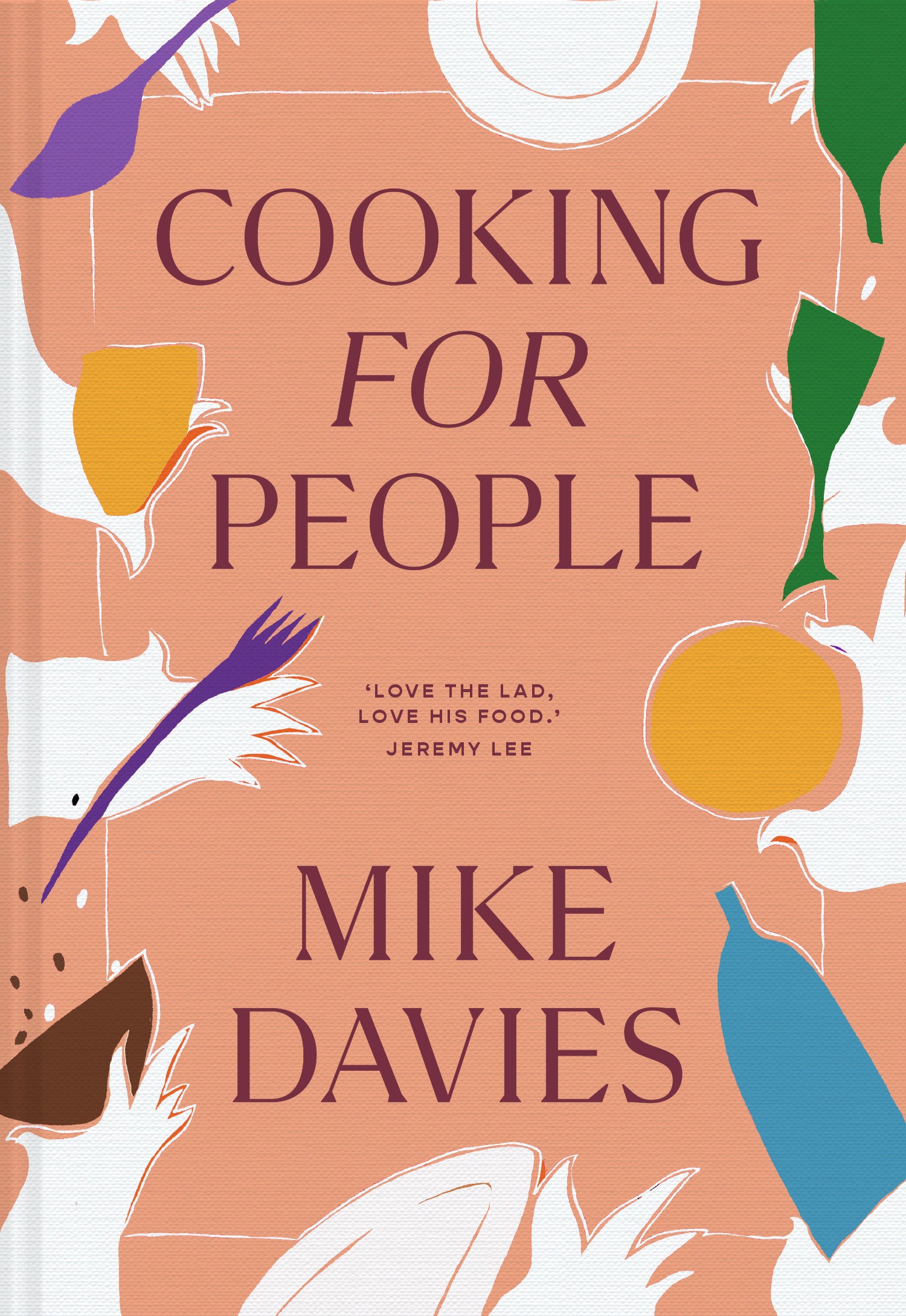
As you can’t taste a pumpkin raw, he recommends buying different varieties and experimenting with them at home until you get used to the flavour and texture.
For example, he’s “been really enjoying using summer squashes at The Camberwell Arms recently,” he says. “They are super juicy and take on the colour of a hard roast or chargrill well because of their natural sweetness.” It’s this kind of advice that fills Cooking for People with ideas for home cooks who might not have considered just how many types of pumpkins (and their cousins) exist. Try roasting them, mashing them or pureeing them in soups, and see which style of pumpkin suits your taste.
The versatile staple: beyond roasting
So, once you’ve picked your pumpkin, what exactly do you do with it? Forget pumpkin spice for a moment – Davies is talking about real cooking. “I love a piece of roasted, spiced pumpkin, but I’ll also never tire of a pumpkin puree stirred through a risotto, or thinly sliced pieces fried in a light batter. The uses are endless.”
In Cooking for People, Davies’ pumpkin and swiss chard rotolo with burst tomatoes and brown butter exemplifies the beauty of pumpkin’s versatility. The dish folds roasted pumpkin, chard and cheese into a pasta roll, crisped to golden perfection and topped with a sage-spiked brown butter that could charm the most committed carnivore. “Pumpkin’s earthy sweetness lends it a perfect pairing for most cheeses with their high salinity and fat content,” he explains. “With some gentle aromatic spices, you can’t really go wrong.” Equally, he says roasting a pumpkin in good olive oil or boiling and mashing it with salty butter will yield delicious results without additional adornment.
From sweet to savoury: endless possibilities
While Davies personally leans towards savoury dishes, he concedes that pumpkin can work in desserts, too. “It absolutely can be done with great effect because of the intrinsic natural sweetness and happy pairing with sweet spices like cinnamon and nutmeg,” he says. But, “I’d say cooking pumpkin in a savoury way wins out.”
Such as in his pumpkin, celeriac and gorgonzola and potato gratin, which takes all those rich, earthy flavours and layers them into a dish that practically demands a second helping. With the bitterness of radicchio and chicory on the side, it’s comfort food that satisfies without sinking you into a post-meal slump.
Nostalgia and comfort in autumnal dishes
Davies’ love for pumpkin runs deeper than simple taste. He sees it as a seasonal fixture, a nostalgic food that captures the shift into autumn. “Pumpkin’s seasonal association runs deep in Western culture, but its versatility and total affinity for the comforting additions of fattier things as the weather changes is what makes it a real seasonal hero,” he says. The vegetable’s ability to adapt to hearty dishes and heavier flavours makes it ideal for autumn and winter meals. And it’s precisely this versatility that keeps people coming back to it, even if only around Halloween.
He has little patience for the idea that peeling and seeding a pumpkin is somehow too much trouble. “If people can get over the initial faff, pumpkin’s myriad of delicious applications should make them a seasonal staple,” he says. After all, when there’s a dish as good as roasted pumpkin with harissa chickpeas and kohlrabi slaw on the line, a bit of peeling and chopping is hardly an ordeal.
Moving beyond Halloween
Halloween may be the pumpkin’s moment in the spotlight, but Davies believes there’s a place for this ingredient year-round. There’s a serious sustainability angle to this, too. By wasting pumpkins each Halloween, we’re missing an opportunity to make use of an ingredient that’s both nutritious and delicious. Imagine if every British household kept and cooked their Halloween pumpkin – roasted in salads, mashed into stews or even spiced and sliced on pizzas. The possibilities are endless, and they all lead to a more sustainable, flavour-packed autumn.
So this year, don’t let your pumpkin suffer the indignity of a post-Halloween bin bag. Try roasting it with harissa, layering it into a gratin or turning it into a rotolo worthy of any dinner table. Or, as Davies might say, just crack open a pumpkin, keep it simple and let the flavours do the talking. Because really, this isn’t about Halloween at all – it’s about making room for one of the most underrated seasonal ingredients in the British kitchen.
If you’re ready to give it a go, here are three recipes from Cooking for People that will elevate your pumpkin game this season.
Pumpkin and Swiss chard rotolo with burst tomatoes and brown butter
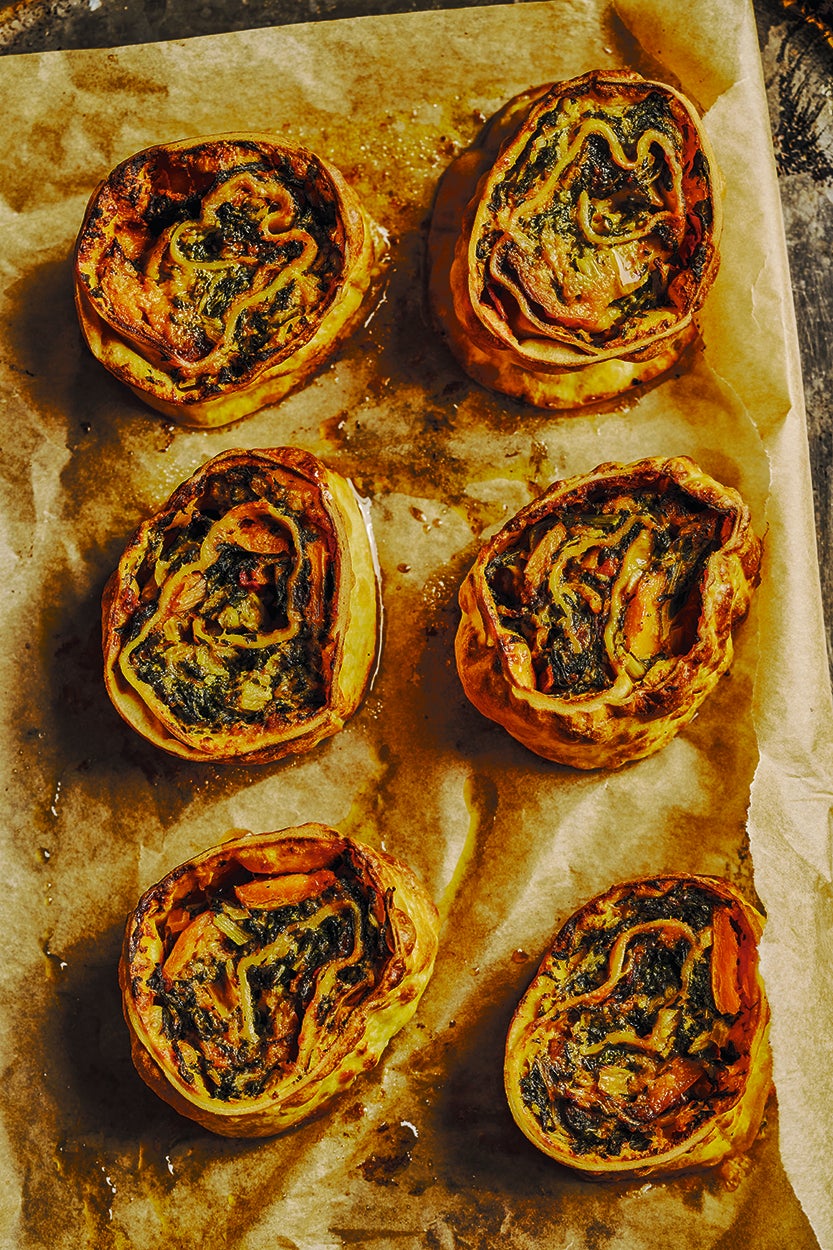
My parents have an allotment, and one of the mainstays of their plot has always been chard. If you cut the large, outer leaves, it just keeps growing, which is great because it’s delicious. It also means thinking up as many uses as you can for chard, and because it does a similar job to spinach, it’s super versatile.
The filling for this rotolo is based on the classic stuffed-pasta filling of spinach and ricotta. The addition of pumpkin lends texture and richness. This is certainly on the more technical side, but if you break it up into stages, it’s a simple dish to prepare for a dinner party from a service perspective because all of it can be done in advance. If you put some work in ahead of time, warming and serving this dish will be a breeze.
For the filling:
Ingredients:
600g pumpkin or squash, peeled, deseeded and cut into 1cm (½in) chunks
Extra virgin olive oil
1kg Swiss chard, roughly chopped
250g ricotta
100g mascarpone
1 white onion, finely diced
Pecorino, to taste
Nutmeg clove, to taste
Salt and pepper
Method:
Preheat your oven to 180C fan/200C/400F/gas mark 6.
Dress the pumpkin with olive oil and season with salt and pepper. Spread it out on a baking tray and roast for approximately 25-30 minutes depending on your oven, until softened and starting to colour. Remove from the oven and allow to cool completely.
Boil the chard in salted water until tender, then lift it out into a colander and allow to cool completely while draining. If you want to expedite this process, you can drop the chard into iced water before removing it and allowing it to drain in a colander. Once the chard is cool, squeeze it with your hands to remove some of the excess water.
Mix the chard with the pumpkin, ricotta, mascarpone and onion. Grate in pecorino and nutmeg to taste and adjust the seasoning. I’d recommend making the filling at least 1 day ahead (2 days is fine) to break up the process of making this dish. Doing so means you don’t have to manage cooling times while rolling the pasta. The mixture will also be much easier to handle once it has set in the fridge overnight.
For the fresh pasta:
The better the eggs, the better the pasta, so don’t skimp. You can make the pasta with a rolling pin if you’re channelling an Italian nonna, but I’d personally only recommend attempting this if you have a pasta roller.
Ingredients:
400g ‘00’ flour
6 egg yolks
2 whole eggs
Semolina, for dusting
Method:
Put the flour in a mixing bowl and make a well in the centre. Add both the yolks and whole eggs, and start to mix the flour into the eggs using a fork. Get your hands in to bring it together, then transfer to a clean work surface. Knead the dough by stretching and folding it over itself for 10 minutes, or until it looks smooth and has a little spring to it. You can also use a stand mixer with the dough hook attachment. Wrap the dough in cling film and put it in the fridge for at least 2 hours. You can make the dough a day in advance if it’s easier and then continue the following day.
To roll the pasta, take the dough out of the fridge and unwrap it. Dust your work surface with semolina and use a rolling pin or the palm of your hand to flatten the dough to the width of your pasta machine. The shape doesn’t really matter at this point, but if the dough feels a little wet, be sure to use plenty of semolina to keep it from sticking.
Set the machine to the thickest setting and roll the dough through it. Turn the setting down one increment at a time, rolling the dough through at each thickness, down to setting 7. Fold the dough in from the ends to a width that will fit through the machine, turn it 90 degrees, then run it back through the machine at the highest setting, once again rolling the dough through at each thickness, this time down to setting 5. Fold the dough again and turn it 90 degrees before passing it through all the settings for a final time, finishing at setting 1. Each run through the machine develops the strength of the pasta, creating a pleasingly firm texture that will hold onto the sauce.
Once you’ve rolled the pasta all the way through to the lowest setting, you should have a fairly large sheet. Dust each side with semolina, and using a knife or pasta cutter, cut the sheet into 6 rectangular pieces, making sure the length will fit in the widest, deep-sided pan with a lid that you have; a large cast-iron casserole dish perhaps. Dust the pasta with semolina and place it on a tray while you get everything ready to make the rotolo.
For the rotolo:
Ingredients:
Salt
Extra virgin olive oil
Method:
Before you start making the rotolo, gather together a couple of clean tea towels, baking paper, kitchen twine, cling film and a pastry brush. Lay the sheets of pasta on baking paper so that the last 2cm (¾in) of each sheet is overlapping along the longer edge with the next to form a large rectangle of pasta. We’re making 2 rolls and each roll will use 3 sheets of pasta. Brush a little water between each overlap to glue the sheets together.
Spread the filling in an even layer, leaving a gap of 5cm (2in) around each edge. Fold one end over onto the filling and start rolling the pasta, using the paper beneath if it helps. Use your hands to even out the thickness as you go, rolling it neatly and tightly all the way to the end of the sheet. Close the ends of the roll by pressing down at each end with your hand and twisting to stick the pasta to itself and then wrap it in baking paper, then a tea towel.
Tie the roll with kitchen twine, starting at either end and then tying a piece of twine every 5cm (2in) or so. Try to keep the string tight as you tie it – ultimately you are trying to create a roll of even thickness. Repeat the process with the second roll.
Fill the biggest pan you have with water, season generously with salt and bring to the boil – a good amount of salt is needed so as to penetrate the centre of the rolls. Carefully place the rolls in the boiling water, put the lid on and simmer for 30 minutes.
Before you lift out the rotolo, place several layers of cling film on a clean work surface, making sure the length is in excess of the size of the rotolo. Pour a tablespoon of olive oil onto the cling film. Lift the rolls out of the water and onto the cling film. Gently peel away the tea towel and baking paper, sliding the rolls onto the oiled cling film. Roll the cling film around each rotolo and allow to cool completely before placing in the fridge to set overnight.
The rotolo will keep like this for up to 3 days before you plan to slice and serve it. Once it’s spent the night in the fridge, you will be able to slice it into as many portions as you like – 2-3 slices per person, depending on thickness, is probably a good amount to aim for. I would recommend slicing the rotolo just before heating and serving to help keep its shape.
For the burst tomatoes:
Ingredients:
500g good little tomatoes, such as Sicilian Datterini
10 garlic cloves
Lots of good olive oil
Salt and pepper
Method:
Preheat your oven to 200C fan/220C/425F/ gas mark 7.
Mix the tomatoes with the garlic and olive oil in a deep-sided tray, ovenproof dish or pan. Season generously and roast for around 15 minutes – the goal is to cook the tomatoes until they have just started to burst.
Remove from the oven and crush a few of the tomatoes with the back of a spoon before leaving to cool. The tomatoes can be cooked up to 2 days ahead of serving and will sit nicely in the fridge.
For the brown butter:
Ingredients:
150g unsalted butter
1 small bunch of sage
Method:
Melt the butter over a medium heat and drop in the sage leaves. As the leaves fry, the butter will caramelize and turn a deep golden brown. Remove from the heat and allow to cool completely, leaving the sage leaves in the butter.
To serve:
Ingredients:
Extra virgin olive oil
50g unsalted butter
Pecorino
Method:
Preheat your oven to 180C fan/200C/400F/gas mark 6 and line a baking tray with baking paper.
Pour a slick of olive oil onto the baking tray and lay out the slices of rotolo on a cut side. Place a slice of butter on top of each piece. Bake for 15-20 minutes until they crisp up around the edges.
Meanwhile, warm the tomatoes in a pan and reheat the brown butter. Plate the tomatoes first, then the rotolo, followed by a splash of brown butter and sage.
Finish with a flurry of pecorino. Writing this recipe felt like a marathon but honestly once you’ve made it once, the steps won’t feel like an obstacle. It’s so worth it.
Pumpkin, celeriac, Gorgonzola and potato gratin with a wintery not-so-green salad
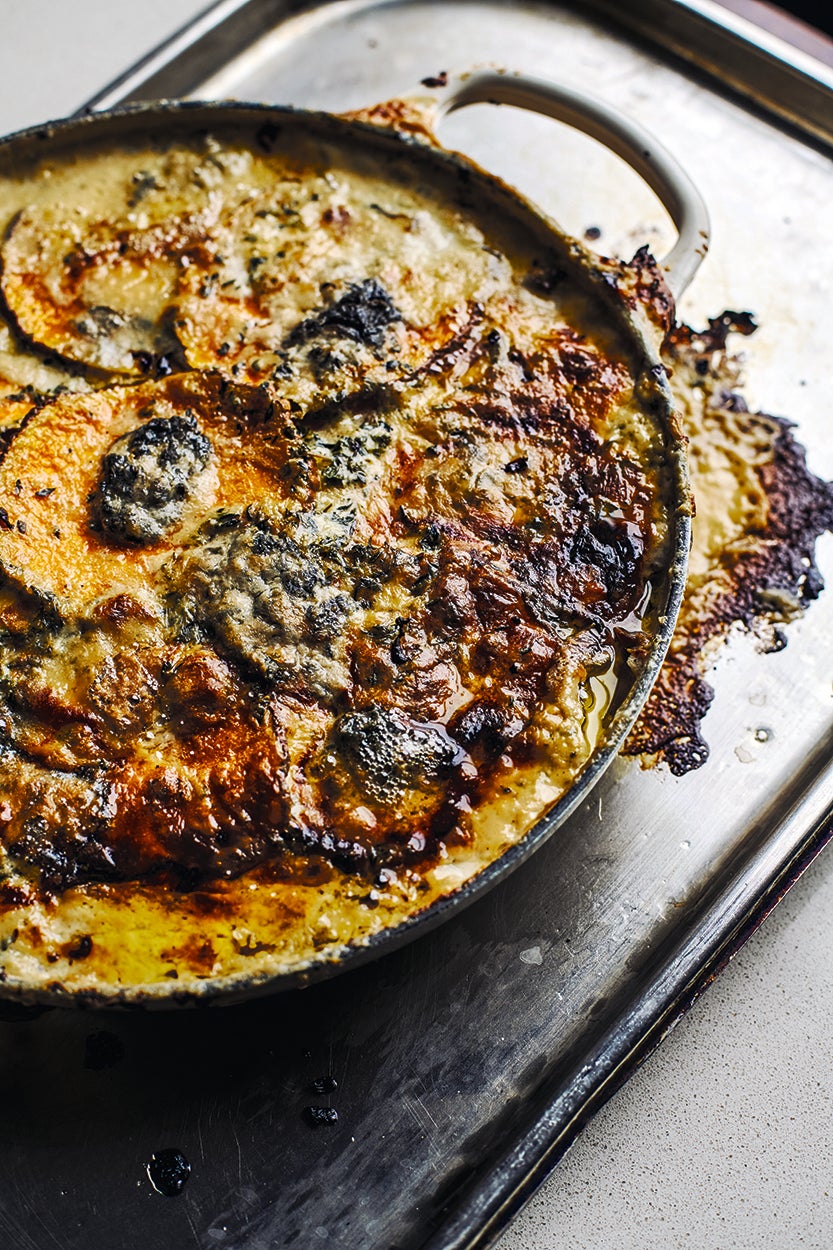
This is peak winter comfort food for me. All of your favourite winter roots baked in a luxurious yet simple sauce. A salad is the best accompaniment to this, particularly if it features the kind of heavyweight bitter leaves I’m suggesting. Bitterness is a terrific counterpoint to richness, trust me.
For the gratin:
Ingredients:
500ml double cream
500ml whole milk
1 bunch of thyme, finely chopped
10 garlic cloves, finely chopped or grated
½ nutmeg clove
1 small pumpkin, such as Delica or Violina, unpeeled, deseeded and thinly sliced
1 small celeriac, peeled and thinly sliced
2 large baking potatoes, thinly sliced
200g Gorgonzola, broken up into a small chunks
125g butter, cubed, plus extra for greasing
Salt and pepper
Method:
Preheat your oven to 180C fan/200C/400F/ gas mark 6 and butter an ovenproof dish or deep roasting tin.
Put the cream and milk in a saucepan over a low heat. Add the thyme, garlic and nutmeg, and season with salt and pepper. Heat very gently for 20-30 minutes so that all the flavours meld but do not allow the mixture to boil.
Build your gratin by layering up alternate pieces of the sliced roots, seasoning with a little salt and pepper as you go and dispersing the Gorgonzola and butter throughout the layers, making sure you leave a little butter and cheese for the top layer. Pour over the cream mixture and top the gratin with the remaining butter and Gorgonzola. Cover with a piece of baking paper and a layer of foil and bake for 30 minutes. Check the texture of the veg with a knife – it’s ready when there is no resistance.
If you’re intending to serve the gratin on the day you make it, go to the next step. If you’re making it ahead of time, allow it to cool at this point and then keep it in the fridge. To finish the gratin, remove the baking paper and foil and bake for a further 15 minutes until burnished and bubbling. If you’re reheating the gratin, it will need 30 minutes to come back to life. It may also need an additional splash of cream or milk before going back in the oven, depending on how much liquid has been absorbed.
For the salad:
Ingredients:
1 large radicchio, such as Treviso, core removed and separated into leaves
2 heads of chicory, core removed and separated into leaves
Extra virgin olive oil
Good vinegar, such as muscatel, sherry, red wine or white wine vinegar
Method:
This is a simple salad. Mix the leaves, dress with oil and vinegar and season to taste. You need the bitterness of the leaves shining brightly next to the earthy comfort of the root vegetable gratin. Lean into the bitterness, it’ll be very welcome.
Roasted pumpkin, harissa chickpeas and kohlrabi slaw with tahini
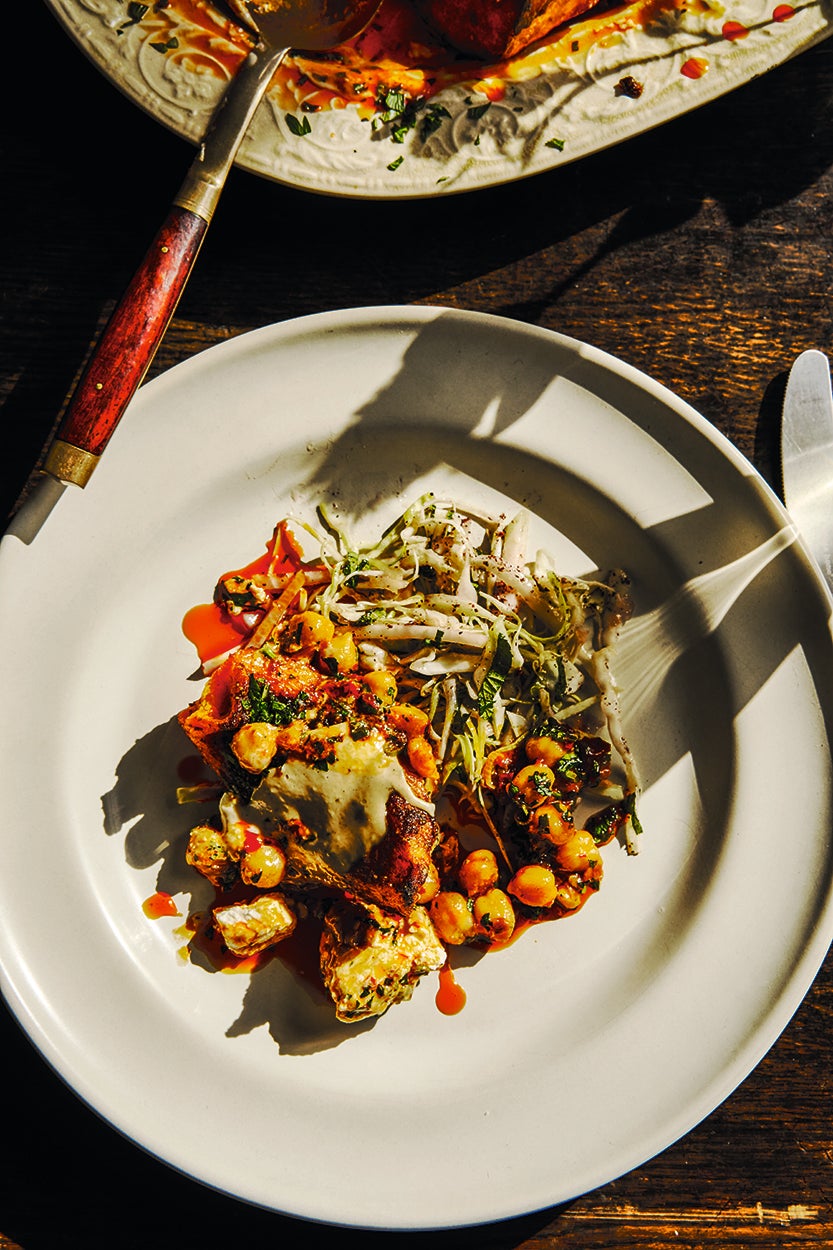
If sweetcorn feels like you’re holding on to summer, pumpkin says you’re happy to embrace autumn. It’s taken me a while to truly enjoy roasted pumpkin because it all too often becomes dry through cooking, and as such can have a bit of a mealy texture. I prefer a slightly wetter textured pumpkin that stays moist when roasted. Of course you can achieve this with liberal amounts of butter or good olive oil which can help with a drier pumpkin, but some pumpkins are just naturally a bit better hydrated.
If you can find them, I love Violino pumpkins, but butternut squash will work just as well. This recipe leans towards Middle Eastern flavours, which lend themselves to vegan cookery perfectly. If I was making this in the pub, we would make our own harissa, because that’s how we roll. Feel free to DIY, but good harissa, such as Belazu’s, can be purchased in most supermarkets.
For the pumpkin:
Ingredients:
1.2kg pumpkin or squash, cut into large wedges and deseeded
1 tbsp dark brown sugar
2 tsp ground cumin
1 tsp ground turmeric
1 tsp chilli flakes
½ tsp ground cinnamon
Extra virgin olive oil
Salt and pepper
Method:
Preheat your oven to 200C fan/220C/425F/gas mark 7.
In a large roasting tin, dress the pumpkin with plenty of olive oil, making sure that there is enough to create a layer in the bottom for cooking beyond just coating the wedges. Dress the pumpkin with all of the spices and sugar before seasoning well with salt and pepper. Roast the pumpkin until it has softened and started to colour – approximately 25-30 minutes, depending on your oven and the size of your pieces.
When the pumpkin wedges have softened and caramelised but are still holding their shape, take the tray out of the oven and allow to cool completely before attempting to move the pumpkin. It’s a lot softer when it’s hot, and you don’t want to break it up too much.
It’s best to roast the pumpkin on the day of serving, but it can be done a day in advance and kept in the fridge, ideally in a single layer so as not to crush it. When you come to serve it, reheat in a 160C fan/180C/350F/gas mark 4 oven for 10 minutes to warm through.
For the harissa chickpeas:
Ingredients:
1 x 700g jar of good-quality chickpeas (Perelló, Bold Bean Co or Navarrico, for example)
2 heaped tbsp good-quality harissa
2 tbsp extra virgin olive oil
1 small bunch of parsley, finely chopped
1 bunch of spring onions, thinly sliced
Zest of 1 lemon
Salt and pepper
Method:
Combine the chickpeas and the liquid from the jar with the harissa and a generous amount of extra virgin olive oil – at least 2 tablespoons. This can be done ahead of time, but honestly it’s so quick, why bother. The chickpeas are cooked, so they only need to be heated through.
Put them in a pan on a low heat and bring to a simmer. Add the parsley, spring onions and lemon zest. Check the seasoning, it probably won’t need much as the beans are a little salty and the harissa packs quite a punch. Serve warm, right away.
For the tahini sauce:
Ingredients:
100g tahini
2 garlic cloves, finely grated
Juice of 2 lemons
300ml water
Salt and pepper
Method:
Put the tahini, garlic and lemon juice in a food processor and start blending, then slowly add the water. This can also be done with a bowl and a whisk. Initially it will thicken, then gradually it will start to loosen and lighten in colour.
Season with salt and pepper. If the mixture feels too thick, you can loosen it further with more water, just make sure to adjust the seasoning if you do. The sauce can be made up to 3 days in advance and stored in the fridge.
For the slaw:
Ingredients:
1 kohlrabi, cut into thin strips or grated
1 small white cabbage, finely shredded
1 bunch of mint, leaves picked and finely shredded
2 tbsp extra virgin olive oil
1½ tbsp white wine vinegar
1 tsp sugar
Sour cherry molasses (optional) – we buy ours online from Belazu, who incidentally have beautiful tahini
Salt and pepper
Method:
Put the kohlrabi, cabbage and mint in a bowl and dress the slaw with olive oil, vinegar and sugar. Season with salt and pepper, and add a tablespoon or so of sour cherry molasses if you’ve managed to find it. The slaw should be light and fresh, slightly acidic, slightly sweet, and not overly oily.
To finish:
Ingredients:
1 small bunch of parsley, chopped
Method:
Heat through your pumpkin and chickpeas if you prepped them ahead, then assemble a platter with chickpeas on the base and pumpkin on the top. Dress the whole plate with tahini sauce and sprinkle over some parsley. Plate the slaw separately and bring it to the table before having at it.
‘Cooking for People’ by Mike Davies (Pavilion, £30).
